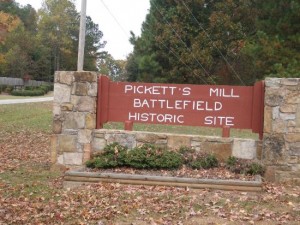Recently I had the opportunity to visit a historic site close to home, Pickett’s Mill, a preserved Civil War battlefield in Dallas, Georgia. In my visit, I learned the rich history behind the the site while experiencing nature and its simplicity. As an avid hiker, I was overjoyed when told that Pickett’s Mill was an acceptable site to visit for the assignment. I gladly hiked the trails with much enthusiasm. The winding paths were filled with greenery and underlying stories – what more could a hiker ask for! After my long and very much exhausting hike, I was able to cool down and relax with a lovely lesson of history pertaining to the battlefields that I had just explored. It’s funny how blind and unaware one can be of their surroundings. I never would have known, nor cared about the events that took place (practically in my backyard) if it was not for the knowledge that I had acquired during my visit. Additionally, I find awe in the idea that events which shaped and impacted our entire nation took place on those trails in which I was able to step foot on.
Pickett’s Mill is a preserved battlefield from the Civil War time period circa the 1800’s. The trails take you through roads that have once been traveled by the Federal army and Confederate troops while the log cabin that also lies on the site portrays an authentic representation of houses during this era. The Federal army yearned to attack the Confederates. Their ultimate target was Atlanta due to its railroads, a developed transportation system (at the time) and a vital aspect for trade. In order to fulfill their orders, the federals prepared by marching into Pickett’s Mill. They were now ready to fight off the Confederate troops in order to gain ground closer to their desired location. As the battling ensued, the Confederates were able to stand their ground and were also able to defend themselves from the attack. Thus, the Federal army was defeated in this event and they ultimately failed their mission. The Union suffered a humiliating loss of the Battle at Pickett’s Mill. Interestingly enough, the battle was so humiliating that Sherman, leader of the Union army, overlooked the event due to embarrassment. The devastating defeat resulted in 1,600 casualties on the Federal side. In fact, witness accounts claimed that dead Federal soldiers were everywhere. To conclude, in regards to the historic significance of Pickett’s Mill, the Federal army battled the Confederate troops in order to advance into Atlanta in hopes of gaining control of the railway system. The fight did not go as planned for the Union as the Confederates defeated their army, killing an immense amount of soldiers. Who would have thought that a vicious battle had occurred on a hiking trail that seemed so peaceful and quaint?
Additionally, I did not have any preconceived ideas or knowledge in regards to the historic aspect of the battlefield. Because of this, I was very open and eager to acquire new information about the site’s rich history displayed in the visitors center. I would recommend this site to others, especially to hikers, because the terrain was lovely to venture upon. As far as the visiting hours, I would not say that they were the most convenient which ultimately could bother others as well. Unfortunately, this site has not made me yearn to visit other historical places. But on the flip-side, Pickett’s Mill has made me want to hike other trails. To conclude, my visit to Pickett’s Mill was filled with new knowledge, and most importantly everlasting memories – memories that have American history intertwined within it.
